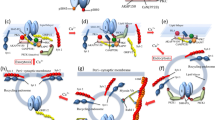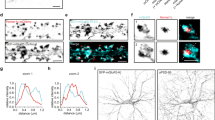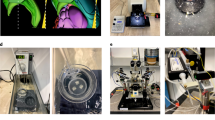Abstract
A CENTRAL assumption about long-term potentiation in the hip-pocampus is that the two classes of glutamate-receptor ion channel, the N-methyl-D-aspartate (NMDA) and the kainate/quisqualate (non-NMDA) subtypes, are co-localized at individual excitatory synapses1,2. This assumption is important because of the perceived interplay between NMDA and non-NMDA receptors in the induc-tion and expression of long-term potentiation: the NMDA class, by virtue of its voltage-dependent channel block by magnesium3,4 and calcium permeability5,6, provides the trigger for the induction of long-term potentiation, whereas the actual enhancement of synaptic efficacy is thought to be provided by the non-NMDA class7,9. If both receptor subtypes are present at the one synapse, such cross-modulation could occur rapidly and locally through diffusible factors. By measuring miniature synaptic currents in cultured hippocampal neurons we show that the majority (∼70%) of the excitatory synapses on a postsynaptic cell possess both kinds of receptor, although to different extents. Of the remaining excita-tory synapses, ∼20% contain only the non-NMDA subtype and the rest possess only NMDA receptors. This finding provides direct evidence for co-localization of glutamate-receptor subtypes at individual synapses, and also points to the possibility that long-term potentiation might be differentially expressed at each synapse according to the mix of receptor subtypes at that synapse.
This is a preview of subscription content, access via your institution
Access options
Subscribe to this journal
Receive 51 print issues and online access
$199.00 per year
only $3.90 per issue
Buy this article
- Purchase on SpringerLink
- Instant access to full article PDF
Prices may be subject to local taxes which are calculated during checkout
Similar content being viewed by others
References
Nicoll, R. A., Kauer, J. A. & Malenka, R. C. Neuron 1, 97–103 (1988).
Brown, T. H., Chapman, P. F., Kairiss, E. W. & Keenan, C. L. Science 242, 724–728 (1988).
Nowak, L., Bregestovski, P., Ascher, P., Herbet, A. & Prochiantz, A. Nature 307, 462–465 (1984).
Mayer, M. L., Westbrook, G. L. & Guthrie, P. B. Nature 309, 261–263 (1984).
MacDermott, A. B., Mayer, M. L., Westbrook, G. L., Smith, S. J. & Barker, J. L. Nature 321, 519–522 (1986).
Jahr, C. E. & Stevens, C. F. Nature 325, 522–525 (1987).
Kauer, J. A., Malenka, R. C. & Nicoll, R. A. Neuron 1, 911–917 (1988).
Muller, D., Joly, M. & Lynch, G. Science 242, 1694–1697 (1988).
Davies, S. N., Lester, R. A. J., Reymann, K. G. & Collingridge, G. L. Nature 338, 500–503 (1989).
Finch, D. M. & Jackson, M. B. Neurosci. Abstr. 13, 310 (1987).
Miledi, R. & Thies, R. J. Physiol., Lond. 212, 245–257 (1971).
Forsythe, I. D. & Westbrook, G. L. J. Physiol., Lond. 396, 515–533 (1988).
Watkins, J. C. & Evans, R. H. A. Rev. Pharmac. Tox. 21, 165–204 (1981).
Honore, T. et al. Science 241, 701–703 (1988).
Fatt, P. & Katz, B. J. Physiol., Lond. 117, 109–128 (1952).
Bekkers, J. M. & Stevens, C. F. Understanding the Brain through the Hippocampus: The Hippocampal Region as a Model for Studying Brain Structure and Function (eds Storm-Mathisen, J., Zimmer, J. & Ottersen, O. P.) (Elsevier, Amsterdam, in the press).
De Camilli, P., Cameron, R., Greengard, P. J. Cell Biol. 96, 1337–1354 (1983).
Martin, A. R. Handbook of Physiology. The Nervous System 329–355 (Am. Physiol. Soc. 1, 1977).
Tang, C.-M., Dichter, M. & Morad, M. Science 243, 1474–1477 (1989).
del Castillo, J. & Katz, B. J. Physiol. 124, 560–573 (1954).
Author information
Authors and Affiliations
Rights and permissions
About this article
Cite this article
Bekkers, J., Stevens, C. NMDA and non-NMDA receptors are co-localized at individual excitatory synapses in cultured rat hippocampus. Nature 341, 230–233 (1989). https://doi.org/10.1038/341230a0
Received:
Accepted:
Issue Date:
DOI: https://doi.org/10.1038/341230a0
This article is cited by
-
Adapting the endoplasmic reticulum proteostasis rescues epilepsy-associated NMDA receptor variants
Acta Pharmacologica Sinica (2024)
-
Asynchronous release sites align with NMDA receptors in mouse hippocampal synapses
Nature Communications (2021)
-
Extracellular matrix remodeling through endocytosis and resurfacing of Tenascin-R
Nature Communications (2021)
-
Segregation of glutamatergic and cholinergic transmission at the mixed motoneuron Renshaw cell synapse
Scientific Reports (2017)
-
The Reduction of EPSC Amplitude in CA1 Pyramidal Neurons by the Peroxynitrite Donor SIN-1 Requires Ca2+ Influx Via Postsynaptic Non-L-Type Voltage Gated Calcium Channels
Neurochemical Research (2014)



